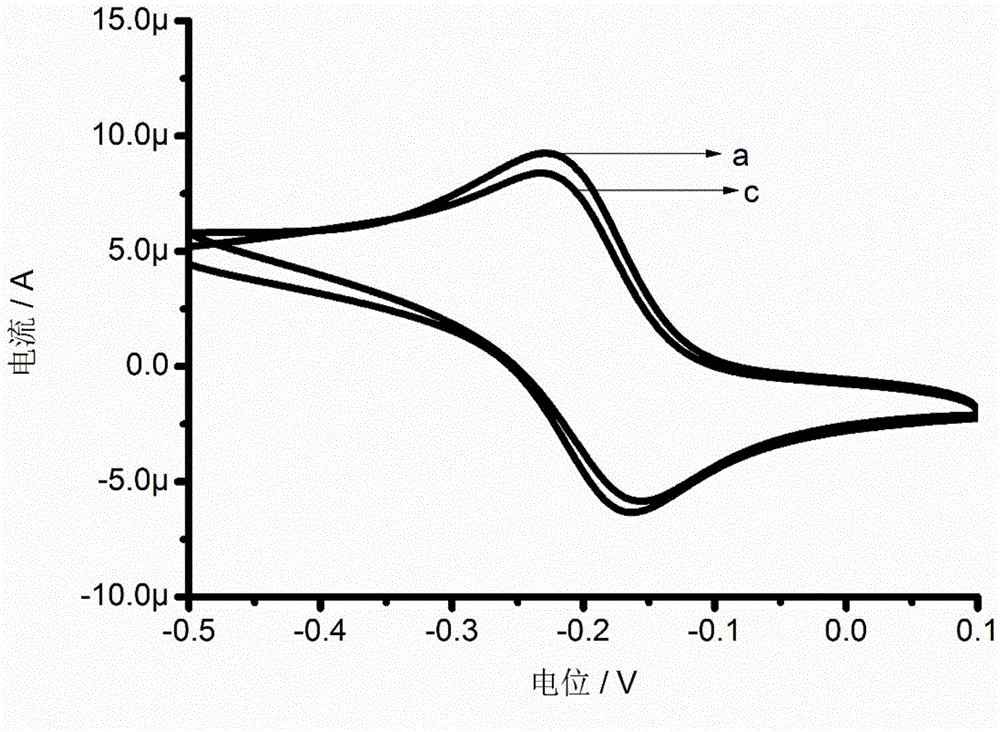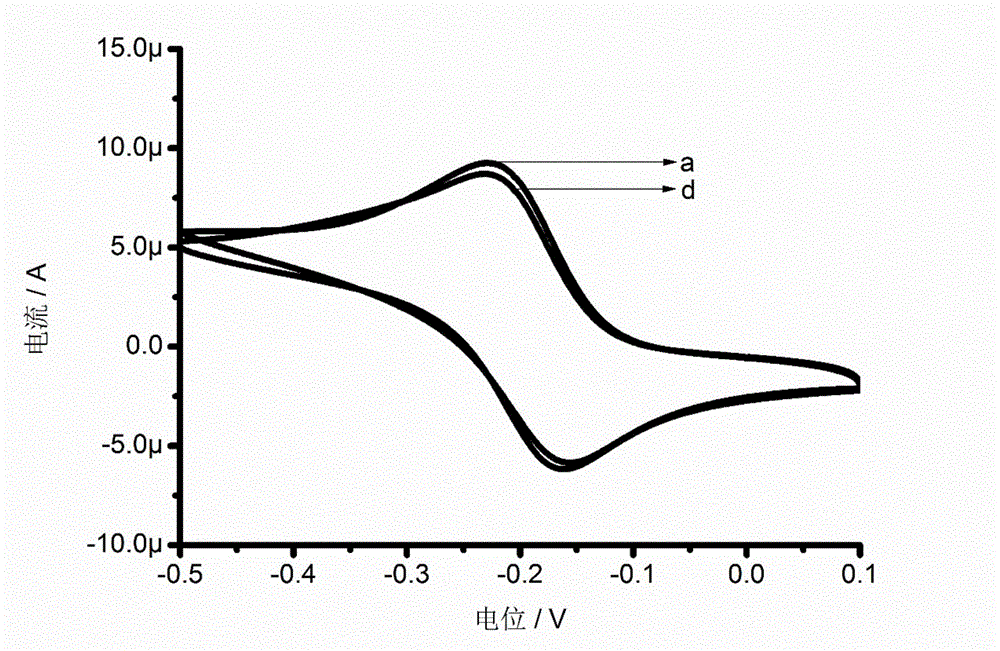Method for orderly assembling DNA and graphene on gold electrode surface
An electrode surface, gold electrode technology, applied in the field of biosensors and electrochemical biosensors, can solve problems such as unreported, and achieve the effects of simple production process, low production cost and good electrochemical performance
- Summary
- Abstract
- Description
- Claims
- Application Information
AI Technical Summary
Problems solved by technology
Method used
Image
Examples
Embodiment 1
[0029] 1) Preparation of ethyl-(3-dimethylpropyl)carbodiimide hydrochloride (EDC) solution: dissolve EDC powder in secondary water and dilute with secondary water to obtain 0.1mol / L EDC solution .
[0030] 2), preparation of N-hydroxysuccinimide (NHS) solution: dissolve NHS powder in secondary water, dilute with secondary water to obtain 0.04mol / L NHS solution;
[0031] 3), the preparation of phosphate buffered saline solution (PBS): get 0.2328g disodium hydrogen phosphate dodecahydrate (Na 2 HPO 4 12H 2 O), 0.0897g sodium dihydrogen phosphate dihydrate (NaH 2 PO 4 2H 2 (0), 0.58g sodium chloride (NaCl) in 250ml volumetric flask, gets 5mM PBS buffer solution with secondary water dilution;
[0032] 4), configuration of double-stranded DNA (dsDNA) solution: 4 single-stranded DNAs of different sequences (ssDNA-1 are modified by thiol at the 5' end; ssDNA-2, ssDNA-3, ssDNA-4 are modified by Amino modification) powder was centrifuged in a centrifuge at 6000rpm for 5min, and ...
Embodiment 2
[0040] Steps 1) to 6) are the same as in Example 1.
[0041]7) Immerse the treated gold electrode in the dsDNA-1 solution for 14 hours, then rinse the surface of the modified gold electrode with secondary water to remove free dsDNA-1, and dry it with nitrogen gas for later use. When the electrode surface state is DNA / Au;
[0042] 8) Add 10 μl EDC and 5 μl NHS to 100 μl 1 mg / ml graphene quantum dot solution, then immerse the gold electrode modified with dsDNA-1 for 6 hours, and then wash the surface of the modified gold electrode twice Rinse with water to remove free GQDs, and blow dry with nitrogen for later use. At this time, the surface state of the electrode is GQDs / DNA / Au;
[0043] 9) Add 10 μl EDC and 5 μl NHS to 100 μl dsDNA-2 solution, then immerse the gold electrode modified with dsDNA-1 and graphene quantum dots for 6 hours, and then wash the surface of the modified gold electrode with Rinse with water twice to remove free dsDNA-2, and dry it with nitrogen gas for l...
Embodiment 3
[0046] Step 1) to 6) are the same as embodiment 1.
[0047] 7) Immerse the treated gold electrode in the dsDNA-1 solution for 18 hours, then rinse the surface of the modified gold electrode with secondary water to remove free dsDNA-1, and dry it with nitrogen gas for later use. When the electrode surface state is DNA / Au;
[0048] 8) Add 10 μl EDC and 5 μl NHS to 100 μl 1 mg / ml graphene quantum dot solution, then immerse the gold electrode modified with dsDNA-1 for 6 hours, and then wash the surface of the modified gold electrode twice Rinse with water to remove free GQDs, and blow dry with nitrogen for later use. At this time, the surface state of the electrode is GQDs / DNA / Au;
[0049] 9) Add 10 μl EDC and 5 μl NHS to 100 μl dsDNA-2 solution, then immerse the gold electrode modified with dsDNA-1 and graphene quantum dots for 6 hours, and then wash the surface of the modified gold electrode with Rinse with water twice to remove free dsDNA-2, and dry it with nitrogen gas for l...
PUM
 Login to View More
Login to View More Abstract
Description
Claims
Application Information
 Login to View More
Login to View More - R&D
- Intellectual Property
- Life Sciences
- Materials
- Tech Scout
- Unparalleled Data Quality
- Higher Quality Content
- 60% Fewer Hallucinations
Browse by: Latest US Patents, China's latest patents, Technical Efficacy Thesaurus, Application Domain, Technology Topic, Popular Technical Reports.
© 2025 PatSnap. All rights reserved.Legal|Privacy policy|Modern Slavery Act Transparency Statement|Sitemap|About US| Contact US: help@patsnap.com



